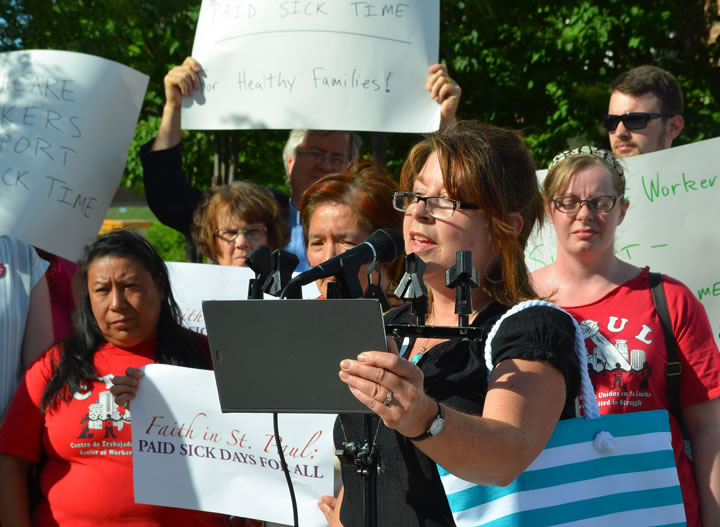

Share
An estimated 70,000 workers in St. Paul could soon be eligible for up to 48 hours of earned sick and safe time a year, under recommendations issued by a city task force.
It’s the latest effort by local governments in Minnesota and elsewhere to adopt measures that protect workers and the public. Minneapolis recently adopted a citywide ordinance and Duluth is considering taking action.
The St. Paul proposal, if adopted by the city’s elected officials, would require employers to provide workers with one hour of sick time for every 30 hours they work, with sick-time earnings capped at 48 hours per year.
“These recommendations reflect three months of work by members of our task force,” said St. Paul Regional Labor Federation President Bobby Kasper, a member of the task force, which included business owners, workers and representatives of several labor organizations. Members were appointed by Mayor Chris Coleman and members of the City Council.
“We heard testimony from public health experts, working people and business owners. After careful consideration and respectful dialogue, we reached a set of recommendations that, I believe, reflect St. Paul’s values.”
The city’s Human Rights and Equal Economic Opportunity Commission received the official recommendations and heard public comments on the issue Tuesday. The commission will make final recommendations regarding a potential ordinance to the City Council and mayor in July, but will continue to accept public input on the issue through July 5 via the city’s website, www.stpaul.gov.
At a rally before Tuesday’s hearing, workers, religious leaders, small business owners and community leaders expressed support for the task force’s recommendations.
The crowd heard the story of Riley Davis, a St. Paul resident and member of Neighborhoods Organizing for Change, who works four jobs but does not have any paid sick time.
“I’ve worked shifts at coffee shops with a fever over 100 degrees, having to take breaks to throw up when I’ve had the flu. I’ve worked at a portrait studio with small children coughing up handfuls of mucus, ready to faint. I’ve pushed myself through since I can’t afford to take time off,” said Davis.
Hilario de Leon, a restaurant worker and janitor who lives and works in St. Paul, “Never in my eight years of having two jobs been able to take a paid sick day when myself or my family are sick.”
Fusion Salon owner Diane Brennan explained why she began offering sick time to employees at her Snelling Avenue business earlier this year.
“My values insist that I take care of my staff and their families because I care about them on a personal level,” she said. “It was the right thing to do.”
The Rev. Javen Swanson of Gloria Dei Lutheran Church in St. Paul, a member of the faith group ISAIAH, said, “The lack of earned sick and safe time in St. Paul is a crisis . . . Implementing earned sick and safe time is just the right thing to do. No one should have to choose between taking care of themselves and paying the rent or putting food on the table.”
In May, the Minneapolis City Council passed the state’s first ordinance requiring employers to provide earned sick and safe time, joining 26 other cities nationwide with such ordinances on the books.
Some of the St. Paul task force’s recommendations, including the accrual formula and 48-hour cap, mirror the Minneapolis ordinance, scheduled to take effect in July 2017. But the Minneapolis ordinance guarantees sick pay only to workers at businesses with six or more employees. At businesses with five or fewer employees, the leave will be unpaid.
The St. Paul task force recommended any ordinance benefit all working people, regardless of the size of their employer. The task force did note that employers with existing arrangements like paid-time off or collective bargaining agreements, as long as they meet minimum recommended standards, would be “deemed compliant.”
The task force recommended employees begin accruing sick time after working 80 hours, and that they become eligible to use their sick time after 90 calendar days of employment.
Although workers’ sick pay would be capped at 48 hours per year, they would be able to bank up to 80 hours.
Sick time, according to the recommendation, could be used to recover from or address a mental or physical illness, as well as time needed for medical diagnosis or preventative care. “Safe time” would apply when an employee or an employee’s family member is a victim of domestic abuse, sexual assault or stalking.

